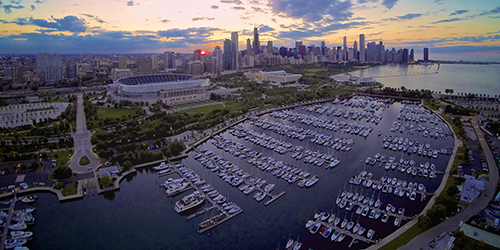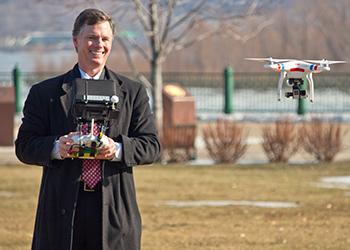Drones bring new heights—and hubbub—for photographers and videographers.
Taking off from the top deck of the Peoria Heights Observation Tower, it ascends, capturing the scene below: the specialty shops of Prospect Road; the beautiful Grand View Drive, buried in treetops; the majestic Illinois River. Atop the tower, Pat Cusack and his family gather together as the drone—a DJI Phantom 2 outfitted with a GoPro Hero4 camera—approaches. It’ll be a bird’s-eye-view family photo for this year’s Christmas card—the perfect way to highlight Pat’s latest hobby to friends and relatives.
As he directs the drone to circle and re-approach the tower, the camera tilts with a gust of wind. Hovering in place for a moment, the drone suddenly begins to hurtle towards the ground. The video’s final frames are still, looking into the trunk of an evergreen tree.
“Up until that point, I had perfect control of it,” says Cusack, who’s been flying drones and remote-controlled planes for years. He believes a nearby radio tower may have interfered with the calibration process that day. He was lucky: aside from the shot for his family’s Christmas card, Cusack lost only a battery in the crash, now documented on his YouTube channel.
A local dentist, Cusack takes these videos simply for fun. Recounting a presentation he gave to a group of colleagues on drones and the current laws—or lack thereof—surrounding them, he acts as if this hobby is the most normal thing in the world. And more and more, it is.
High-Tech on the Rise
Digital news outlet Quartz has dubbed 2015 “the year of the super-cheap, camera-equipped drone,” capable of traveling a few thousand feet high and priced under $100. The technology has come a long way, adds Colin Hinkle, another drone hobbyist. Just a few years ago, the Washington native purchased his first drone from specialty retailer Brookstone for about $300. “It was pretty basic,” he says. “You could fly it around, and it had its own built-in camera, which wasn’t very good.” After losing that first model to the waters of Bora Bora, Tahiti, on a vacation, the long-time photographer was ready for an upgrade.
“I would view videos from other photographers… online, and I noticed they were getting these shots, and I just wondered, ‘How are they doing it?’” Hinkle recounts. After some research, he determined the DJI Phantom 2 equipped with a GoPro was the way to go. “It has a lot more stability than the first one I had and a lot more safety features—such as a built-in GPS, so it knows where it’s at in any given moment. “When you take off, it actually marks where you’re at as a home point,” he adds. “If you let go of the controls, it will stop and hold its position based on the satellite coverage. And if something happens—for example, the connection between me and the drone gets lost due to interference—it will stop what it’s doing and return back to me.” For Hinkle, the safety features are a major bonus, especially in light of the uncertain legal and regulatory environment surrounding consumer drones.
Know Before You Fly
Over the past few years, in the absence of action by the Federal Aviation Administration (FAA), the states have begun to address the regulation of drones. According to the National Conference of State Legislatures, 20 states have enacted laws addressing unmanned aircraft systems, with a focus on the use of drones by government agencies and law enforcement. Here in Illinois, House Bill 1652, signed into law in 2013, forbids a person from impeding hunters or fishermen by “using a drone in a way that interferes with another person’s lawful taking of wildlife or aquatic life.” Meanwhile, the Freedom from Drone Surveillance Act, effective January 1, 2014, provides that law enforcement agencies may not use drones to gather information except to counter a high-risk terrorist attack or by first obtaining a search warrant, or under “reasonable suspicion that swift action is needed to prevent imminent harm to life or serious damage to property.”
At present, no Illinois laws govern safety in the use of consumer drones by hobbyists. However, a special bulletin issued recently by the FAA reminds consumers that “all unmanned aircraft used for commercial or business purposes” are subject to its regulation; at minimum, any such flights require a certified aircraft and certified pilot. And yet, a recent federal court decision in a related case maintains that it cannot regulate commercial drone activity. While it appeals that decision, the FAA is set to complete its full regulations by fall of this year. In the meantime, the agency has offered some guidance.
In a video released just in time for those who received drones under last year’s Christmas tree, knowbeforeyoufly.org, a campaign sponsored by the FAA in conjunction with a number of related organizations, lays out some best practices for new owners of unmanned aircraft. “How do you stay off the ‘naughty’ list?” it asks. “We want you to know before you fly. It’s time to have fun with your new unmanned aircraft, but… you need to learn to fly safely.” The video lists the follow dos and don’ts:
- Do fly your unmanned aircraft below 400 feet.
- Don’t fly your aircraft beyond your line of sight.
- Do fly with local clubs.
- Don’t fly near airports and any manned aircraft.
- Do take a lesson before you fly.
- Don’t fly near people or stadiums.
- Do inspect your aircraft before you fly.
- Don’t fly anything that weighs more than 55 pounds.
- Do fly for fun.
- Don’t fly for payment or commercial purposes unless specifically authorized by the FAA.
- Don’t be careless or reckless; you could be fined if you endanger people or other aircrafts.
- Do be safe, and know before you fly.
Hinkle is well aware of these concerns. “That’s where I try to focus my abilities,” he says. “I try to abide specifically to [their] rules: don’t fly higher than 400 feet, don’t fly within five miles of an airport, don’t fly near large crowds. If you watch my videos, most of the time the scenes are empty because I’m flying on a Saturday or Sunday morning at 9am when hardly anyone is out.”

Cusack also abides by these recommendations, but in anticipation of stricter laws, he’s trying to capture all the videos that he can now. “People are doing crazy things with these [drones],” he notes, recalling a video he found online of someone taking a drone up to 5,000 feet—into the airspace of some planes. Because of such recklessness, he expects a crackdown to come soon. Still, he asserts, the potential for consumer use of drones is huge, especially for photography and videography.
Where We Cannot Go
Real estate agent Mark Monge and his wife, Jennifer, have been taking aerial photos in the Peoria area for about a year. Their shots—also taken with a DJI Phantom 2 and a high-definition camera—are remarkable, offering unique perspectives not possible from the ground.
“We started doing it because we had some amazing properties that were on spectacular settings, and we just couldn’t capture that by normal means,” Mark explains. “We really wanted to be able to highlight all of the features, whether it was the setting, the architecture, the view or a combination of all three, and aerial photography was the only way to do that.”
As the FAA continues to draft its regulations, the Monges have gone the extra mile to ensure that privacy is a top consideration. “We have only utilized it on homes where we can make sure neighboring properties are not included, and we only take the photos when there aren’t any neighboring cars or people out and about,” he assures. “We respect people’s privacy above all else—that of our clients as well their neighbors.”
So far, the response has only been positive. ”Our clients who are selling appreciate the extra effort and photographic results… and our clients who are buying also like the photos, as it allows them to get a feel for a property and what it has to offer. Sometimes that’s the key ingredient,” he asserts. “A home’s success rate for selling can depend a lot on how it is marketed… and this allows us to provide that advantage to our clients.”
Hinkle also appreciates the incredible angles that drones can provide. Now a Chicago resident, he founded his own company, Soaring Badger Productions, to display his photos and videos from the sky. “I started making these videos… just for fun,” he explains. “But… people started contacting me and saying, ‘Hey, we love what you’re doing! Could we possibly commission you to go shoot some video for us?’ or… ‘Can we buy the rights to use some of the footage?’ That’s happened multiple times.”
And that’s where it gets tough, he explains. As Hinkle inched closer toward the line of commercial use, he applied to the FAA last summer for a waiver to fly commercially and “do it their way.” Today, he’s still waiting on that lengthy process, which requires his drone to receive an aircraft registration number like any other plane. So far, the FAA has issued just over a dozen regulatory exemptions—not nearly enough to keep up with the backlog.
“My hope is that the FAA will continue to issue waivers to individuals who have applied and in the next year or two, open it up to a quicker process where you can… get a response back within 60 days,” he says. “With the amount of drones being sold every day on Amazon and everywhere else on the web, they can’t possibly keep up at the speed they’re going right now. They need to… get in front of this.”
“The potential’s great,” Cusack notes. “Anyone can make a theater-quality movie… It really gives people a chance to experiment with their artistic side,” he adds, citing another online video, taken by a drone from inside a firework, and still another, taken while soaring over a volcano spewing up lava. Drones can go where people cannot—a significant benefit, but it’s also what scares so many.
Drones have a bad rap, Hinkle suggests. He believes common-sense regulations and the continued use of personal drones for photography will help to reverse the negative connotations that people often associate with the word. “Sometimes when I tell people that I fly a drone, they look at me like I’m flying military aircraft, and I’m like, ‘No, this thing hasn’t been to Afghanistan,’” he laughs. “This is a toy—essentially, an expensive toy.” a&s
Watch Pat Cusack’s videos at youtube.com/user/peoriapc:, check out Colin Hinkle’s videography at soaringbadgerproductions.com, and look for Mark Monge’s shots at blog.markmonge.com.


